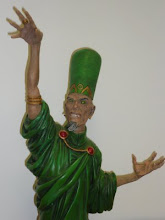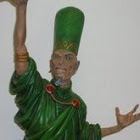 This is a heartfelt, superbly structured and beautifully written book about why a journalist was murdered on the 2 August 2007 in Oakland, California. The story is a wide ranging history of a radical religion, fraud, the hideous results of racism, greed, incompetence and the bottomless well of human malice, desire for power and dominance.
This is a heartfelt, superbly structured and beautifully written book about why a journalist was murdered on the 2 August 2007 in Oakland, California. The story is a wide ranging history of a radical religion, fraud, the hideous results of racism, greed, incompetence and the bottomless well of human malice, desire for power and dominance.Thomas Peele places the killing of Chauncey Bailey in its context of the dreadful history of violent racism that runs through American history. Chauncey Bailey was killed because he was a journalist and he was killed to prevent a story being published. The fact that he was an African-American and was killed by a member of the Black Muslim sect in Oakland is just one of the sad and horrible facets to this case that Thomas Peele illuminates.
There are four broad threads to the narrative, the first is the response to the attack on the freedom of the press that the murder of Chauncey Bailey represents and that Thomas Peele as a fellow journalist wants to forcefully respond to. The next broad thread is the ugly and murderous history of racist repression and oppression that was rampant in American society throughout the last century. The third broad thread is the miserable history of Oakland, referred to memorably as the "shitbox of the west". Finally there is the extraordinary and heartbreaking story of the Nation of Islam, a cold-hearted fraud that violently traded on the rage and deep despair of African-Americans to benefit a small number of staggeringly corrupt men. In a carefully researched, artfully structured book, Thomas Peele shows how each of the these threads slowly wound across each other and finally lead to the murder of Chauncey Bailey.
The vicious depths of the fraud carried out by the Nation of Islam and its breakaway sect in Oakland are laid bare in all their sordid and mean details. The exploitation of the rage, sorrow and dislocation of fellow African-Americans is a sad and moving story. The actions of the chief fraudsters themselves are eye watering in their depravity, malice and destructiveness. In particular Yusuf Bey, the patriarch of the Black Muslim sect in Oakland and founder of Your Black Muslim Bakery, which was the linchpin of his criminal enterprise was an appalling man. A serial child abuser on a very significant scale he ruined the lives of an uncountable number of people in the pursuit of power, vanity and money.
Yusuf Bey flourished in Oakland due to spectacular incompetence, indifference and civic apathy that has dogged Oakland throughout its history. All of these factors played direct contributing parts in the murder of Chauncey Bailey.
Thomas Peele tells a very specific and particular story, rooted firmly in a location that quietly and effectively casts a revealing light across a dark slice of current history. This is a griping book, easy to read and chilling in its revelations. Journalism may be the first draft of history, this is is simply superbly written history.




